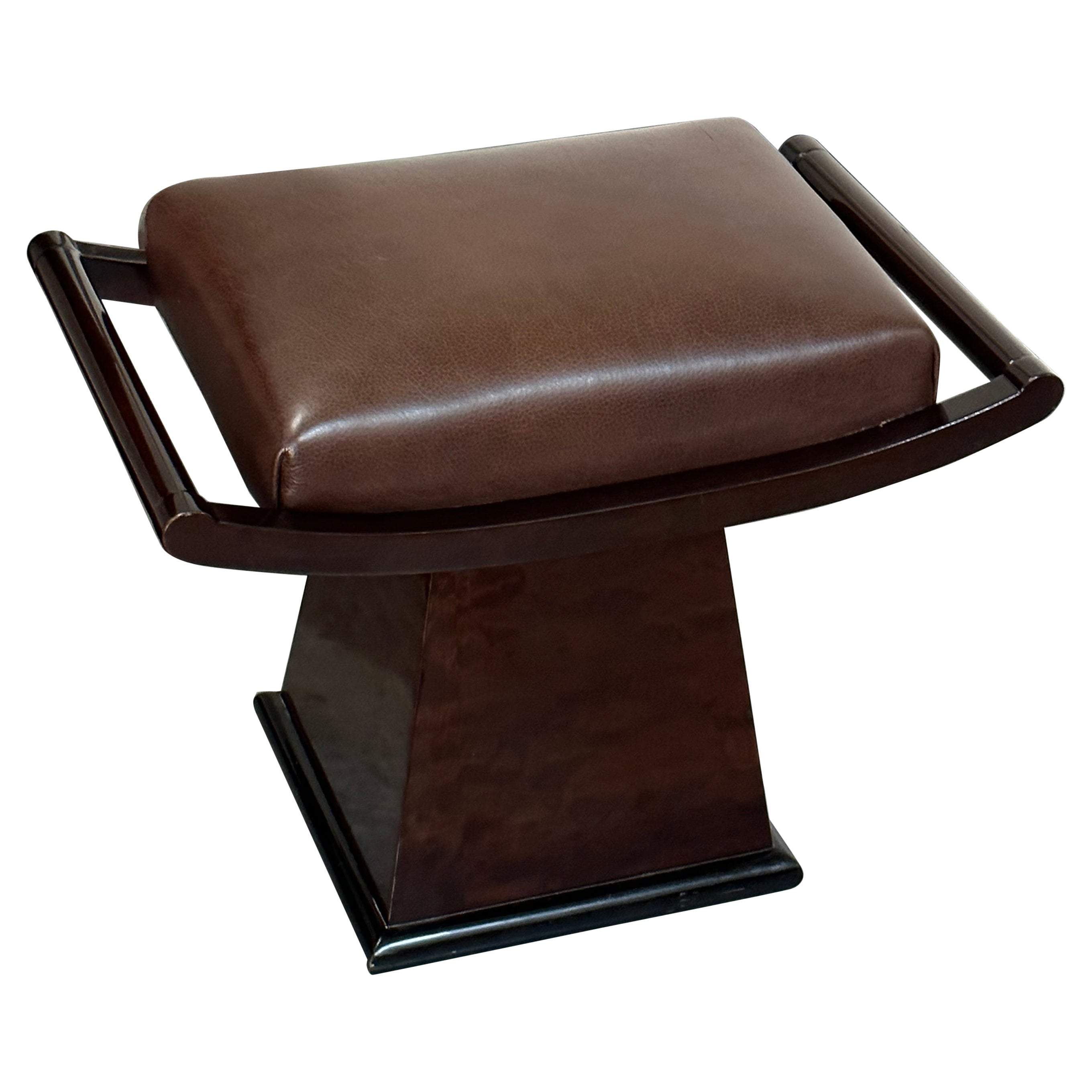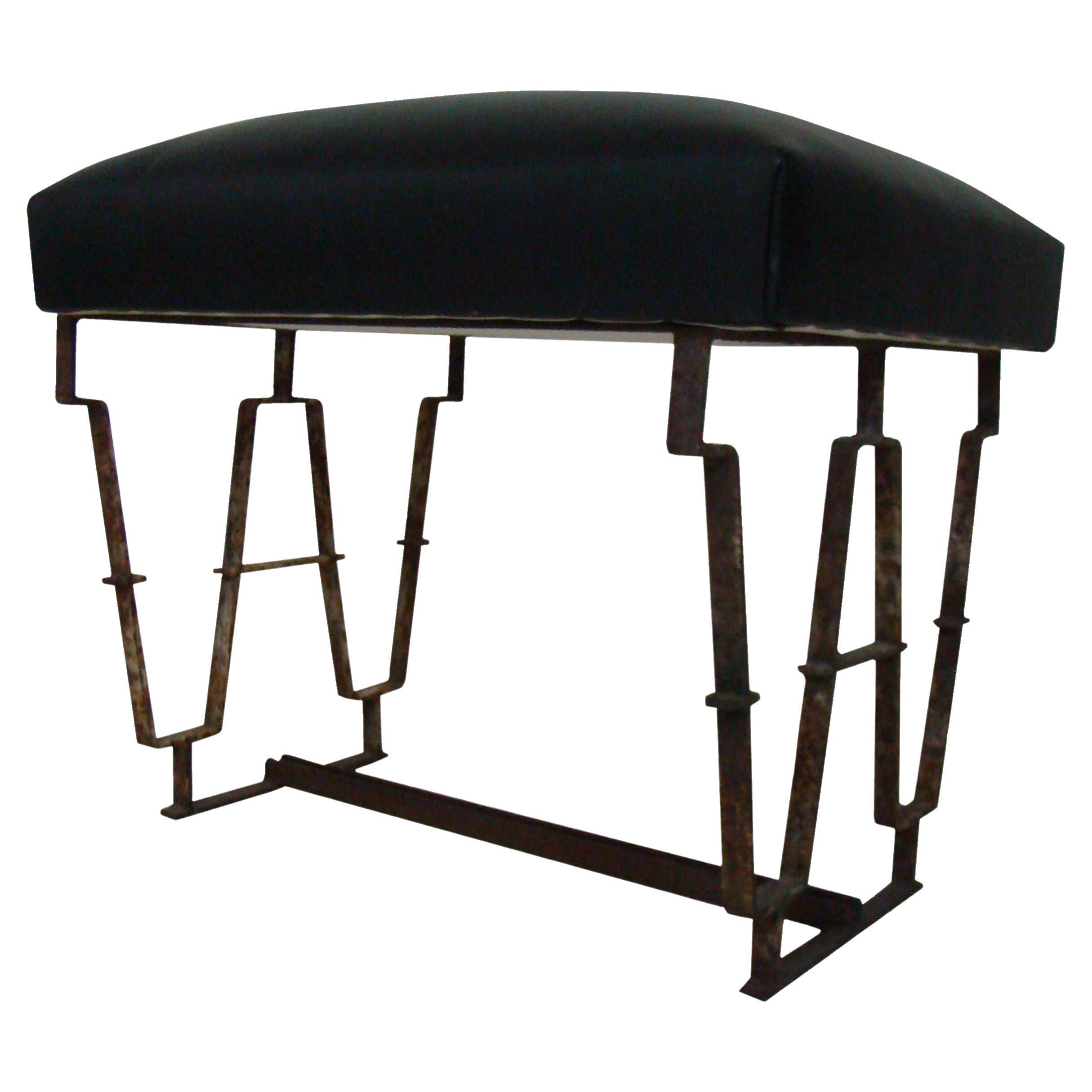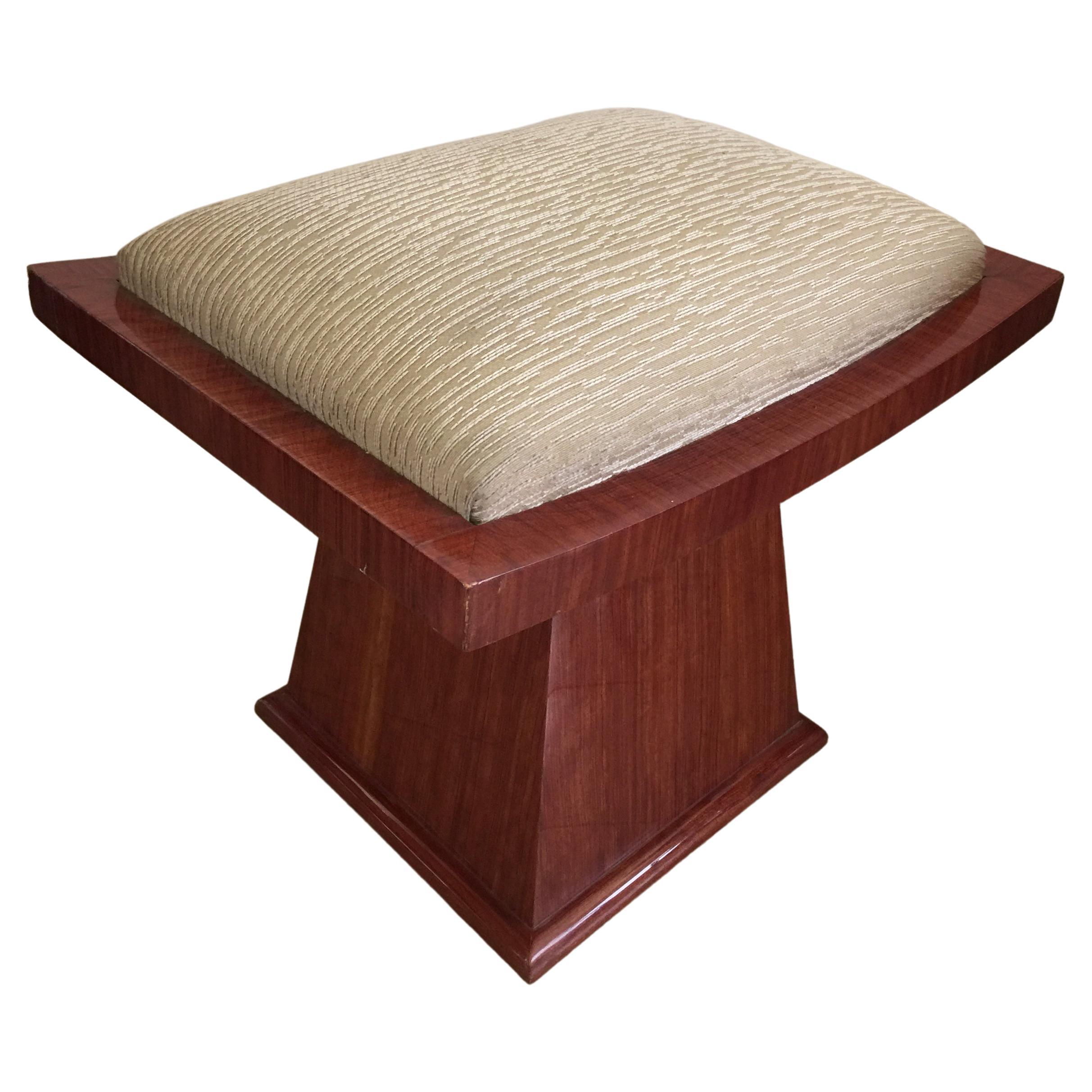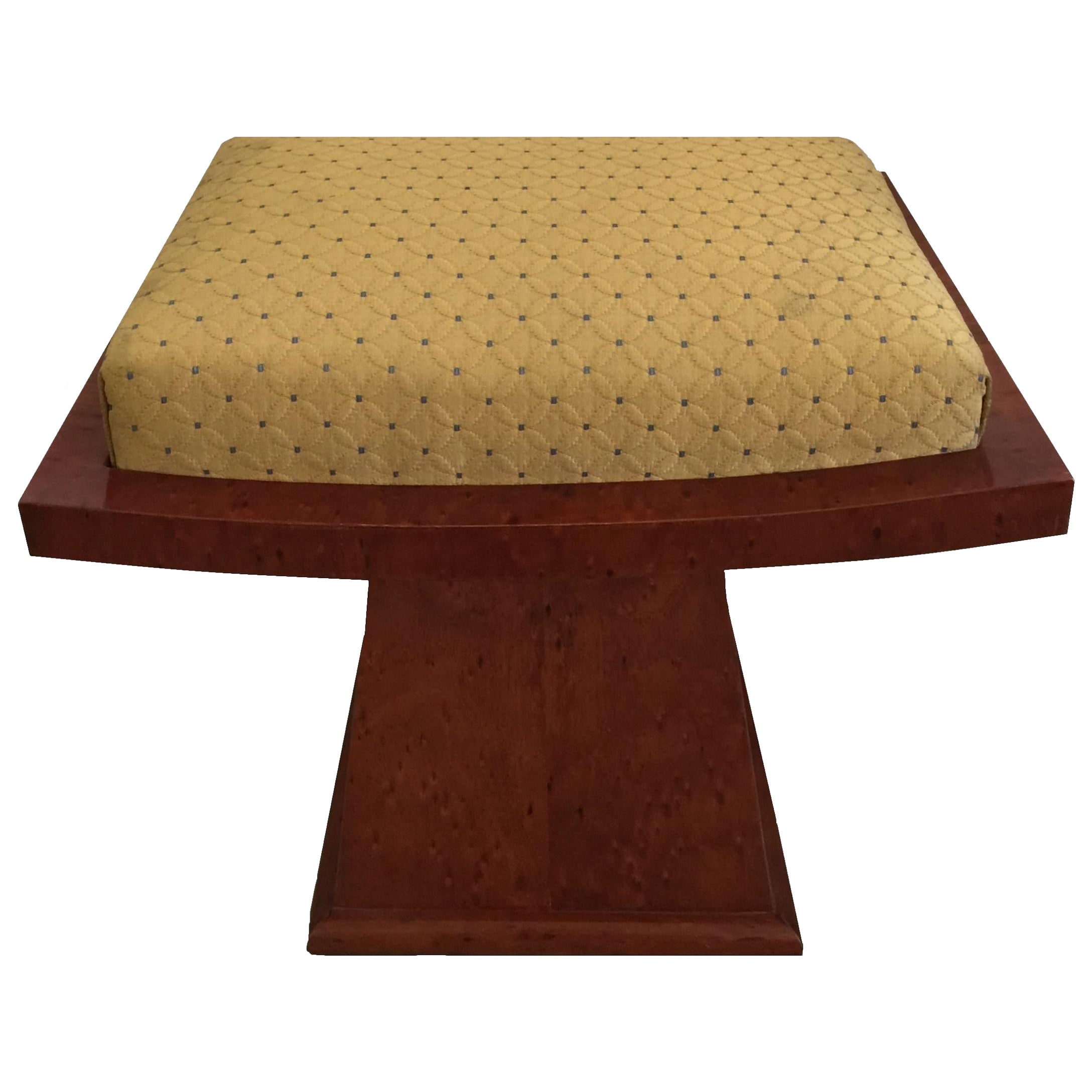Items Similar to Bauhaus Stool, Material, Chrome and Leather, Country German, 1940
Video Loading
Want more images or videos?
Request additional images or videos from the seller
1 of 7
Bauhaus Stool, Material, Chrome and Leather, Country German, 1940
About the Item
Stool
Material: chrome and leather
You want to live in the golden years, this is the stool that your project needs.
We have specialized in the sale of Art Deco and Art Nouveau and Vintage styles since 1982. If you have any questions we are at your disposal.
Pushing the button that reads 'View All From Seller'. And you can see more objects to the style for sale.
Bauhaus
The Staatliche Bauhaus (house state-building) or simple The Bauhaus, was the school of the design, art and architecture founded in 1919 by Walter Gropius in Wimar (Germany) and closed by the prussian authorities (in hands of the nazis) in 1933. The name of Bauhaus cames from the german junction between Bau that means “of the construction” and Haus, “house”, ironically, although it´s name and the fact that his founder was an architect, The Bauhaus don´t had an architecture department in the first years of it existence. The Bauhaus school was based in three cities: 1919 – 1925: Weimar 1925 – 1932: Dessau 1932 – 1934: Berlín It was managed by three Directors: 1919 – 1927: Walter Gropius 1927 – 1930: Hannes Meyer 1930 – 1933: Ludwig Mies van der Rohe The founding of the Bauhaus occurred at a time of crisis of modern thought and Westerntechnical rationality in the whole of Europe and particularly in Germany. It was created by the confluence of political, social, educational and artistic conjuntion in the two first decades of the XX century, whose specificity is given by the artistic vanguards of the begining of the century. Conservative modernization of the German Empire during the 1870's held power in the hands of the aristocracy.That also required the militarism and the imperialism to keep the estability. By 1912 the rise of leftist SPD had galvanized political positions with concepts of international solidarity and socialism set against imperialist nationalism. Sectors of the proletariat demonstrate a growing capacity for organization, which is necessarilyenhanced by the German hyperinflation and the increasingly obvious economic crisis.Like other movements belonging to the artistic avant-garde, the Bauhaus was notmarginalized from political processes and social, while maintaining a high degree ofcriticism, and commitment to left. The Bauhaus-as evidenced by the problems he had with politicians who did not see sympathetically acquired the reputation of being deeplysubversive. The Bauhaus was also a big vital experiment of the community of young people (1400 aproximately) that, after the collapse of the old order and the traumatic experience of the recently finished World War I, was launched thrilled to build a social utopia, new forms of coexistence. Were held legendary parties at the Bauhaus, usually breaks (white party, party metal, party of comets) and almost always dress in its organization and design work for weeks. The parties had two aims: firstly to promote contact between the school and the public toallay fears that the institution generated in the population and, secondly, to promoteteamwork and cooperation and serve as a catharsis to the tensions and conflicts tha toriginated in the Bauhaus as a result of the close link between work and private life. In addition to these parties 'official' means any event was equally likely to lead to acelebration ... In the moment of its foundation the objectives of the school, characterized by Groupius in manifest, were: “The recovery of the artisans methods in the constructive activity, rise the artisans potential at the same level of the Bellas Artes, and try to commercialize their products, in the industry, that will become common object that anybody could buy” , because one of its goals to achieve was to reach the independence and begin to sell their products elaborated at school, to stop the State dependence, that at the moment were who subsided it. In the moment of its foundation the objectives of the school, characterized by Groupius in manifest, were: “The recovery of the traditional methods in building activity, raising the power level of handmade fine arts and try to market products, integrated into the industrial production, consumer goods become affordable to the public "as one of his goals was to become independent and start selling products made in the school, to wean the State so far was subsidizing whom.
Why are there so many antiques in Argentina?
In the 1880 – 1940 there was a grate wave of immigration encouraged by the periods of war that were taking place.
1st World War took place between 1914 and 1918
2nd World War took place between 1939 and 1945
The immigrants options were New York or Buenos Aires. Tickets were cheap and in Buenos Aires they were welcomed with open arms, as it was a country where everything was still to be done.
Argentina was the country of new opportunities, labour was needed and religious freedom was assured, in many cases of the family travel first until they were settled and then the rest of the family members join them.
In the immigrant museum “Ellis Island Immigrant Building” in New York you can se the promotional posters of the boats that would take them to a new life.
Between the years 1895 and 1896, Argentina had the highest DGP (gross domestic product) per capita in the world according to the Maddison Historical Statistics index, this situation arose due to the large amount of food being exported to European countries, which were at war.
The Argentinean ships left the port of Buenos Aires with food, but they returned with furniture, clothes and construction elements, (it´s common to see this the old buildings of the historic neighbourhood of San Telmo, the beams with the inscription “Made in England)”, as well as many markets that were built in Buenos Aires, such us the San Telmo Market, whose structure was brought by ship and afterwards assembled in 900 Defensa Street.
With the great influence of European immigrants living in the country, the children of the upper classes travelled to study in France, resulting in the inauguration of “La Maison Argentinienne”, on 27th of June 1928, in the international city of Paris, which hosted many Argentinians that were studying in Frace.
It´s the fourth house to be built after France, Canada and Belgium, being the first Spanish-speaking one. Still in place today (17 Bd Jourdan, 75014, Paris, France). Many of the children of these wealthy families who attended international art exhibitions, museums and art courses abroad, took a keen interest in the European style. This is why Buenos Aires was at the time referred as “The Paris of South America”.
Between the years 1890 and 1920 more than a hundred Palaces were built on Alvear Avenue the most exclusive avenue in Buenos Aires. Today some of these palaces have been transformed into museums, hotels and embassies.
In the year 1936, the Kavanagh building was inaugurated, it was the tallest reinforced concrete building in South America.
During 1994 the American Society of Civil Engineers distinguished it as an “international engineering milestone”, and it´s now considered a World Heritage of Modern Architecture.
At the time was common to hire foreign architects such as Le Corbusier, who visited Buenos Aires/Argentina in 1929 and in 1948 he drew up the blueprints for a house built in La Plata City (which was declared a World Heritage Site).
In 1947, the Hungarian architect Marcelo Breuer designed “Parador Ariston” in the seaside city of Mar del Plata. After an Argentinean student at Harvard University convinced him to come to Argentina. He worked on an urban development project in the Casa Amarilla, area of La Boca.
The Ukrainian architect, Vladimiro Acosta, arrives in Argentina in 1928 and worked as an architect until que moved to Brazil.
Antonio Bonet, a Spanish architect who worked with Le Corbusier in Paris, arrives in Argentina in 1937, where he carried out several architectural works and in 1938 designs the well-known BFK chair.
Andres Kálnay, of Hungarian origin, made around 120 architectural masterpieces, among which the former Munich brewery stands out, he even made the furniture’s design.
The German architect, Walter Gropius, director of the Bauhaus, lived in Argentina, where he wrote articles for “Sur” magazine and founded in Buenos Aires, an architectural firm with Franz Möller, who was also an architect, where he built two houses.
At the same time several famous designers decided to immigrate to Argentina, among them we can find the well-known French designer, Jean-Michel Frank, who arrived in the country in 1940 and also worked for the Rockefeller family.
Special pieces were made, which were sold exclusively in the country, such as the well-known German company “WMF”, who sold their products by catalogue, which were chosen by the ladies of high society in the list of wedding gifts, as well as the pieces designed by Christofle.
The Swiss sculptor Alberto Giacometti, made special pieces for Argentinean mansions.
In 1904 the first Jansen branch outside Paris was established in Buenos Aires, as the Argentinean clientele demanded a large amount of furniture, from the end of the 19th century to the mid-20th century.
In 1970, the brand Rigolleau Argentina made pieces authorised by Lalique.
The brands Maple and Thompson also set up shop in the country.
The French plastic artist, Marcel Duchamp moved to Argentina in 1918-1919.
Glass signed Gallé, Charder, Leverre, Schneider, Muller and other French firms. They were bought in flower shops and were given to ladies with beautiful floral arrangements.
Some furniture manufacturers travelled to international fairs and bough the patterns to produce the furniture in Argentina, such as the furniture firm Englander and Bonta, who bought the patterns ins Italy.
It is worth mentioning that in Argentina we have the largest community of Italians outside of Italy, as it is estimated that 70 percent of the inhabitants have at least one Italian descendant, followed by Spanish immigrants.
The most Important furniture stores in Argentina:
Comte is founded in 1934 (under the direct management of Jean Michel Frank in 1940).
Nordiska (Swedish company established in 1934).
Churba in 1960, a company that brought foreign designers to present their furniture in the country:
Denmark: (Arne Jacobsen, Finn Juhl, Bender Madsen, Ejner Larsen, Poul Kjaerholm, Hans Wegner)
Sweden: (Hans Agne Jakobsson, Gustavsberg)
United States: (Herman Miller)
Finland: (Lisa Johansson, Folke Arstrom, Tapio Wirkkala, Alvar Aalto, Timo Sarpaneva)
Swedish Factory: (Orrefors)
Italy: (Littala, Vico Magistretti, Emma Gismondi, Gae Aulenti, Angelo Mangiarotti, Elio Martinelli, Gianna Celada, Angelo Mangiarotti, Mario Bellini, Carlo Scarpa)
Finland: (Olivia Toikka)
Plata Lappas (Lappas Silver): a goldsmith shop founded in 1887 in Argentina by Alcibiades Lappas of Greek origin.
In 2019, in Argentina took place “the Art Deco world congress”, in which we participated as hosts invited by Geo Darder, founder of the Copperbridge – Foundation, in which prominent people from all over the world attended to learn about Art Deco in Argentina.
Argentina currently has more than 100 Art Deco buildings and another 90 Art Nouveau buildings throughout the city of Buenos Aires.
Argentina is a country that has not been involved in many wars, which is why it has been a refuge for works of art and antiques from different periods of time, unlike European countries. That is way many collectors, museums and antique dealers from all over the world visit it, you should not miss the opportunity to visit this great country.
Laura Guevara Kjuder, architect.
- Dimensions:Height: 18.51 in (47 cm)Width: 21.26 in (54 cm)Depth: 18.12 in (46 cm)
- Style:Bauhaus (Of the Period)
- Materials and Techniques:
- Place of Origin:
- Period:
- Date of Manufacture:1940
- Condition:Refinished. Wear consistent with age and use.
- Seller Location:Ciudad Autónoma Buenos Aires, AR
- Reference Number:
About the Seller
5.0
Vetted Seller
These experienced sellers undergo a comprehensive evaluation by our team of in-house experts.
Established in 1982
1stDibs seller since 2022
21 sales on 1stDibs
Typical response time: <1 hour
- ShippingRetrieving quote...Ships From: Ciudad Autónoma Buenos Aires, Argentina
- Return PolicyThis item cannot be returned.
More From This SellerView All
- Art Deco Stool, Material Wood and leather, Country France, 1930Located in Ciudad Autónoma Buenos Aires, CStools Art Deco. Material: wood and leather You want to live in the golden years, this is the stool that your project needs. We have specialized in the sale of Art Deco and Art Nouve...Category
Vintage 1930s French Art Deco Stools
MaterialsWood, Leather
- Art Deco Stool, Material Iron and Leather Country France, 1930Located in Ciudad Autónoma Buenos Aires, CStools Art Deco. Material: iron and leather You want to live in the golden years, this is the stool that your project needs. We have specialized in the sale of Art Deco and Art Nou...Category
Vintage 1930s French Art Deco Stools
MaterialsIron
- Art Deco Stool, Material Iron and Brown Leather Country France, 1930Located in Ciudad Autónoma Buenos Aires, CStools Art Deco. Material: iron and leather You want to live in the golden years, this is the stool that your project needs. We have specialized in the sale of Art Deco and Art Nou...Category
Vintage 1930s French Art Deco Stools
MaterialsIron
- Art Deco Stool, Material Iron, Country France, 1930Located in Ciudad Autónoma Buenos Aires, CStools Art Deco. Material: iron You want to live in the golden years, this is the stool that your project needs. We have specialized in the sale of Art Deco and Art Nouveau styles since 1982.If you have any questions we are at your disposal. Pushing the button that reads 'View All From Seller'. And you can see more objects to the style for sale. Why are there so many antiques in Argentina? In the 1880 – 1940 there was a grate wave of immigration encouraged by the periods of war that were taking place. 1st World War took place between 1914 and 1918 2nd World War took place between 1939 and 1945 The immigrants options were New York or Buenos Aires. Tickets were cheap and in Buenos Aires they were welcomed with open arms, as it was a country where everything was still to be done. Argentina was the country of new opportunities, labour was needed and religious freedom was assured, in many cases the of the family travel first until they were settled and then the rest of the family members join them. In the immigrant museum “Ellis Island Immigrant Building” in New York you can se the promotional posters of the boats that would take them to a new life. Between the years 1895 and 1896, Argentina had the highest DGP (gross domestic product) per capita in the world according to the Maddison Historical Statistics index, this situation arose due to the large amount of food being exported to European countries, which were at war. The Argentinean ships left the port of Buenos Aires with food, but they returned with furniture, clothes and construction elements, (it´s common to see this the old buildings of the historic neighbourhood of San Telmo, the beams with the inscription “Made in England)”, as well as many markets that were built in Buenos Aires, such us the San Telmo Market, whose structure was brought by ship and afterwards assembled in 900 Defensa Street. With the great influence of European immigrants living in the country, the children of the upper classes travelled to study in France, resulting in the inauguration of “La Maison Argentinienne”, on 27th of June 1928, in the international city of Paris, which hosted many Argentinians that were studying in Frace. It´s the fourth house to be built after France, Canada and Belgium, being the first Spanish-speaking one. Still in place today (17 Bd Jourdan, 75014, Paris, France). Many of the children of these wealthy families who attended international art exhibitions, museums and art courses abroad, took a keen interest in the European style. This is why Buenos Aires was at the time referred as “The Paris of South America”. Between the years 1890 and 1920 more than a hundred Palaces were built on Alvear Avenue the most exclusive avenue in Buenos Aires. Today some of these palaces have been transformed into museums, hotels and embassies. In the year 1936, the Kavanagh building was inaugurated, it was the tallest reinforced concrete building in South America. During 1994 the American Society of Civil Engineers distinguished it as an “international engineering milestone”, and it´s now considered a World Heritage of Modern Architecture. At the time was common to hire foreign architects such as Le Corbusier, who visited Buenos Aires/Argentina in 1929 and in 1948 he drew up the blueprints for a house built in La Plata City (which was declared a World Heritage Site). In 1947, the Hungarian architect Marcelo Breuer designed “Parador Ariston” in the seaside city of Mar del Plata. After an Argentinean student at Harvard University convinced him to come to Argentina. He worked on an urban development project in the Casa Amarilla, area of La Boca. The Ukrainian architect, Vladimiro Acosta, arrives in Argentina in 1928 and worked as an architect until que moved to Brazil. Antonio Bonet, a Spanish architect who worked with Le Corbusier in Paris, arrives in Argentina in 1937, where he carried out several architectural works and in 1938 designs the well-known BFK chair. Andres Kálnay, of Hungarian origin, made around 120 architectural masterpieces, among which the former Munich brewery stands out, he even made the furniture’s design. The German architect, Walter Gropius, director of the Bauhaus, lived in Argentina, where he wrote articles for “Sur” magazine and founded in Buenos Aires, an architectural firm with Franz Möller, who was also an architect, where he built two houses. At the same time several famous designers decided to immigrate to Argentina, among them we can find the well-known French designer, Jean-Michel Frank, who arrived in the country in 1940 and also worked for the Rockefeller family. Special pieces were made, which were sold exclusively in the country, such as the well-known German company “WMF”, who sold their products by catalogue, which were chosen by the ladies of high society in the list of wedding gifts, as well as the pieces designed by Christofle. The Swiss sculptor Alberto Giacometti, made special pieces for Argentinean mansions. In 1904 the first Jansen branch outside Paris was established in Buenos Aires, as the Argentinean clientele demanded a large amount of furniture, from the end of the 19th century to the mid-20th century. In 1970, the brand Rigolleau Argentina made pieces authorised by Lalique. The brands Maple and Thompson also set up shop in the country. The French plastic artist, Marcel Duchamp moved to Argentina in 1918-1919. Glass signed Gallé, Charder, Leverre, Schneider, Muller and other French firms. They were bought in flower shops and were given to ladies with beautiful floral arrangements. Some furniture manufacturers travelled to international fairs and bough the patterns to produce the furniture in Argentina, such as the furniture firm Englander and Bonta, who bought the patterns ins Italy. It is worth mentioning that in Argentina we have the largest community of Italians outside...Category
Vintage 1930s French Art Deco Stools
MaterialsIron
- Art Deco Stool, Material Wood, Country France, 1930Located in Ciudad Autónoma Buenos Aires, CStools Art Deco. Material: wood You want to live in the golden years, this is the stool that your project needs. We have specialized in the sale of Art Deco and Art Nouveau style...Category
Vintage 1930s French Art Deco Stools
MaterialsWood
- Art Deco Stool, Year 1930, Material Wood, Country FranceLocated in Ciudad Autónoma Buenos Aires, CStools Art Deco. Material: wood You want to live in the golden years, this is the stool that your project needs. We have specialized in the sale of Art Deco and Art Nouveau style...Category
Vintage 1930s French Art Deco Stools
MaterialsWood
You May Also Like
- Country View Amish Handcrafted Mission Oak Low StoolsLocated in Germantown, MDA solid pair of country view amish handcrafted mission oak low stools or footstools in great vintage condition. Measure 15 inches in width, 13.5 inches i...Category
Late 20th Century American Arts and Crafts Stools
MaterialsOak
- Rosewood and Leather Camel Saddle StoolsBy M. Hayat & Bros Ltd.Located in Denton, TXCarved Indian rosewood foot stools with tufted black leather and brass inlay by old school furniture manufacturing Company, M. Hayat & Bros is ove...Category
20th Century Pakistani Other Footstools
MaterialsBrass
- Mid century Big Stool, Germany, 1970sLocated in Praha, CZMade in Germany Made of Wood, fabric Good Original condition Seat height 45 cmCategory
Vintage 1970s Czech Mid-Century Modern Footstools
MaterialsWood, Fabric
- Brutalist Leather and Carved Oak StoolLocated in Brooklyn, NYbeautiful stool with nice leather patina from the 1960's/ 1970's, missing one stud.Category
Mid-20th Century French Mid-Century Modern Stools
MaterialsLeather, Oak
- PH Stool, Brass Legs, Mahogany Veneer, Red Lamb Leather on Panels and SeatBy Poul HenningsenLocated in Copenhagen, DKThe PH stool is perfectly proportioned to match the PH dressing table or stand-alone as a functional sculpture. The PH stool is available in maho...Category
2010s Danish Bauhaus Stools
MaterialsLeather, Mahogany
- Ph Stool, Wood Legs, Mahogany Veneer, Red Lamb Leather on Panels and SeatBy Poul HenningsenLocated in Copenhagen, DKThe PH Stool is perfectly proportioned to match the PH Dressing Table or stand-alone as a functional sculpture. The PH Stool is available in mahogany, bla...Category
2010s Danish Bauhaus Stools
MaterialsLeather, Mahogany
Recently Viewed
View AllMore Ways To Browse
Used Event Furniture
Vintage Furniture Sites
Vintage Furniture Site
Vintage Leather Carry On
Vintage Leather Shop
Market Place Used Furniture
Country Antique Dining Sets
German Boat
Seaside Living Furniture
German 1938
German Furniture On Sale
Century 19th Country Spanish
Brazilian 1940
Vintage Furniture Worthing
Vintage 1940 Germany
1940 German Poster
19th Century South German
1970s Bauhaus Style





